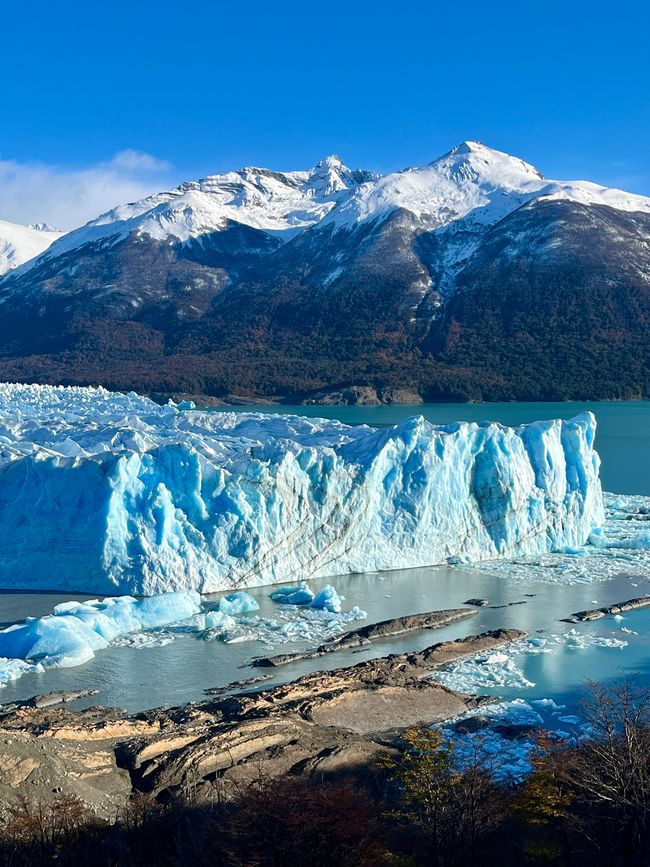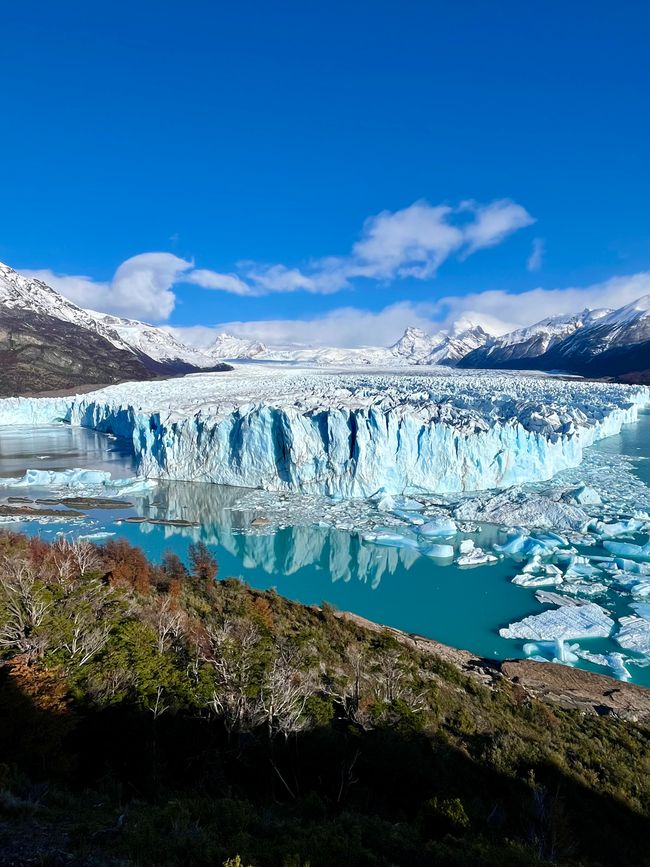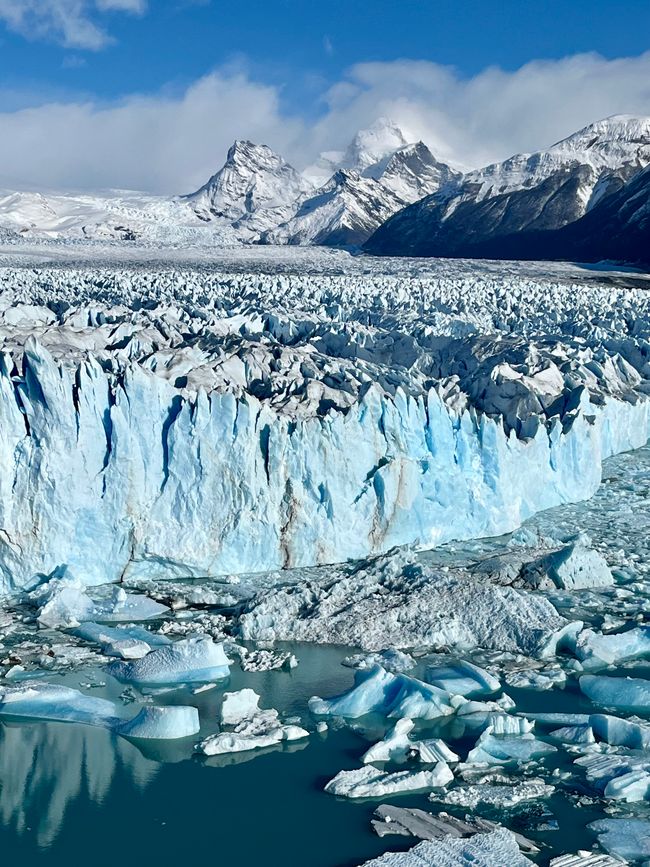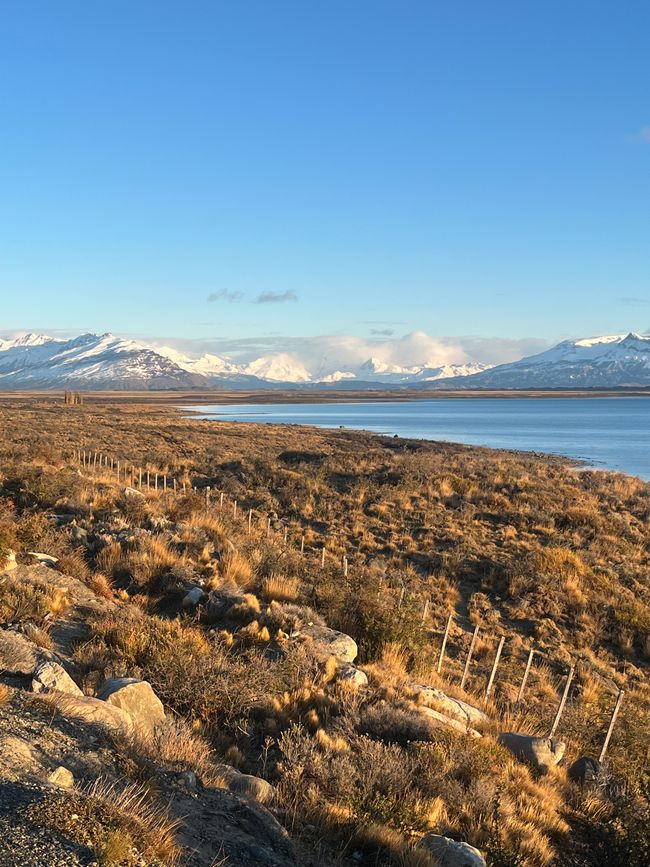Perito Moreno Glacier
उजवाडाक आयलां: 27.06.2024

























With Elisa, a girl from Nantes whom I met on the second tour in Torres del Paine and who stayed with me at the hostel, I set off early in the morning from Puerto Natales to El Calafate in Argentina. The city is the starting point for the tour to the Perito Moreno Glacier. Because this should be the main reason for staying in El Calafate. The journey there was once again very diverse in terms of landscape, and after crossing the border into Argentina, the familiar picture reappeared: the snow-covered peaks of the Andes in the background, lakes, hills, and kilometers-long wild fences with all sorts of carcasses. I have often wondered how the guanacos manage to jump over the fences, but this quickly resolved when I saw several of the animals hopping effortlessly over the barrier. Impressive, but it probably requires some practice and those who fail end up as a carcass in the fence and serve as a meal for the next rank in the food chain.

In addition, when looking out of the window, you regularly notice small red houses with all sorts of flags and other decorations, a kind of shrine where people honk or stop to give offerings while passing by, food, snacks, money, or even alcohol and cigarettes. The recipient of the offerings is Gauchito Gil, a folk saint of the Argentines, surrounded by numerous legends. A kind of Robin Hood who deserted during the Argentine Civil War to avoid having to fight against his compatriots. According to legend, he then hid in the forest, robbed the rich, and gave to the poor. After his capture and subsequent death sentence, Gaucho Gil told the executioner that his sick son would recover if he prayed to him, otherwise he would die. However, the executioner still cut Gaucho's throat, went home, and found his son very ill. He then prayed to Gaucho Gil and his son recovered. Such stories can of course be dismissed as charlatanism, but for many Argentines, he is considered a saint and a kind of patron saint for car, bus, and truck drivers. And since I have personally had a good experience with a patron saint in Buenos Aires, I am fully on board with the locals here. ;)
In El Calafate, one is immediately greeted again by an army of stray dogs, which did not leave our side for the 2 km from the bus station to the hostel. In addition, one enjoyed once again the advantages of the off-season, with very few tourists in the small town, and the hostel with over 50 beds was only shared with 2 other individual tourists. After a short visit to the town, which is located picturesquely on Lake Argentino, a transfer to the glacier was organized for the next day, and the anticipation increased at the thought of the natural spectacle to be seen the next day.

Early in the morning, we were picked up by the bus at the hostel, and on the hour and a half journey to Los Glaciares National Park, we also received very interesting information about the flora and fauna of the area. At the last stop before the glacier, you could already see the natural spectacle from a hill, and you were impressed, even though this was only a first distant view. Fascinating to see the ice wall suddenly protruding between the mountains. Shortly after, we were dropped off at the hiking trail to the glacier from the bus and now the observation from up close was to take place, as this was the goal of today's excursion. A superbly constructed hiking trail, made mostly of wood, awaited the curious visitors, and after a few minutes downhill, one stood in front of this monster for the first time and couldn't close one's mouth. What a sight, this colossus of ice, and the silence of nature, which is quite fitting to the scenery, was only disturbed by the constant creaking and cracking of the glacier.
After a short time of observing, a huge piece of ice broke off from the flank of the glacier with a loud bang and briefly disappeared into Lake Argentino before resurfacing as an iceberg. Absolutely impressive and at the same time a reminder that the mass of ice here is constantly moving. With a speed of up to 2 meters per day, the Perito Moreno Glacier winds its way along the third-largest ice field on earth through the breathtaking landscape of southern Patagonia before sticking its tongue into Lake Argentino. The ice masses rise up to 70 meters high at the front and it is not until you see one of the excursion boats in the corner of your eye, moving at a safe distance from the glacier, that you get a sense of the dimension of this colossus. You had a total of 5 hours to move around on the hiking trails and observe the Perito Moreno Glacier from various angles. Since I was extremely lucky with the weather again and only a few clouds in the distance marred the blue sky throughout the day, I simply sat in the sun at one of the viewpoints for what felt like an eternity and admired the different shades of blue and the rugged structure of the ice, while very few other visitors crossed my path. Simply wonderful, such an impressive natural spectacle and almost having it all to yourself. It feels a bit like an exclusive performance. Smaller and larger pieces of ice break off from the glacier from time to time and gradually drift into Lake Argentino. The fresh fractures leave behind a beautiful light blue color, and even after prolonged observation, it is difficult for the viewer to take their eyes off this natural beauty. The time until the bus departure is savored until the last minute, and on the return journey to El Calafate, one is still overwhelmed and grateful to have been able to experience this spectacle of nature up close.

The Perito Moreno Glacier is one of the very few glaciers worldwide, if not the only one, that is currently not retreating. Various sources even report an increase in the mass of ice in recent times, although researchers cannot see a clear trend here and the extent of the ice masses remains at least stable.
जाप

प्रवास अहवाल आर्जेन्टिना

